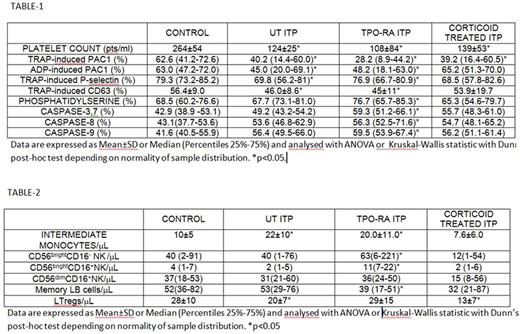Abstract
Background: The heterogeneous pathophysiology of immune thrombocytopaenia (ITP) may explain the wide variation in the presentation of the disease, the clinical course and the response to therapeutic treatments. Among them, agonists of thrombopoietin receptor (TPO-RA) were incorporated as a second line agent for the management of ITP patients who do not respond to other treatments. We hypothesized that platelet and white cells from these patients might present some characteristics different from those observed in ITP patients who don't need to be treated and those responders to a first line therapeutic agent. In order to test this hypothesis we designed this study to evaluate platelet function and distribution of lymphocyte´s compartments in three ITP patient's groups: 1) untreated (UT) and treated with 2) TPO-RA or 3) corticoids.
Materials and Methods: We recruited 33 UT ITP patients (30% male), 35 treated with TPO-RA (45% male), 15 with corticoids (25 % male) and 96 healthy controls (42% male).The La Paz Universitary Hospital Ethics Committee approved the experimental protocol.
Platelet-activation, granule's content release, surface exposure of phosphatidylserine (PS) and activities of caspase-3, -8 or -9 were assessed by flow cytometry (respectively performed with PAC1, anti P-selectin and anti-CD63 antibodies, from BD; Annexin V from BD Pharmingen and Millipore kit).
The frequency of T (CD3+, CD4+, CD8+) and B (CD19+) lymphocytes, natural killer (NK) CD56bright and CD56dim and regulatory T (Treg) [CD4+CD25+ forkhead box protein 3(FoxP3)+] were determined by multi-parametric flow cytometry panels (BD Biosciences).
The statistical analysis of the experimental data was using SPSS 9.0 software (SPSS Inc., Chicago, Illinois, USA).
Results: Platelet count were similar in all ITP groups but lower than controls (p<0.001). Platelet activation, evaluated by binding of PAC1 (antibody that only recognizes the active form of fibrinogen receptor) after the stimulation with TRAP (an agonist for PAR-1 receptors), were equally reduced in all ITP groups. Platelet activation with ADP was only reduced in the TPO-RA ITP patients. A diminished exposure of P-selectin and CD63 was also observed in UT and TPO-RA ITP patients after platelet stimulation with TRAP (Table 1). No differences were observed in surface expression of CD41, CD61, CD42a and CD42b between ITP patients and healthy controls. Platelet apoptosis evaluation showed that ITP patients tended to have an increased activity of caspases -3,7,-8 and -9 activities, but this observation was significant only in the ITP group of treated with TPO-RA (Table 1).
Regarding lymphocytes, no differences were observed in LT subsets among all groups. Intermediate (IM, CD14++CD16+), but not non-classical (NCM, CD14+CD16++) and classical (CM, CD14++CD16-) monocytes were increased in UT and TPO-RA ITP patients. CD56brightCD16- NKand CD56brightCD16+NK, abundant cytokine producers with a weak cytotoxic activity, were increased only in TPO-RA ITP patients. In this group a diminution was observed in memory LB cells. Regarding LTreg population, their count was reduced in UT and corticoid-treated patients, whereas their values reach normality in the TPO-RA treated group (Table 2).
Conclusions: All ITP patients, untreated or responders to treatment with TPO-RA and corticoids recovered platelet count but not its function. TPO-RA-responders patients showed an increased apoptosis compared to the other ITP patients recruited. Nevertheless, TPO-RA seems to have a beneficial regulatory effect on immune system that might counteract platelet destruction.
Work supported by grant from FIS-FEDER PI15/01457. NVB holds a Miguel Servet II (FIS-FEDER CP14/00024).
Álvarez-Roman: Shire: Consultancy; Novo Nordisk: Consultancy. Jimenez-Yuste: Novo Nordisk: Consultancy, Honoraria, Research Funding; Roche: Consultancy.
Author notes
Asterisk with author names denotes non-ASH members.


This feature is available to Subscribers Only
Sign In or Create an Account Close Modal